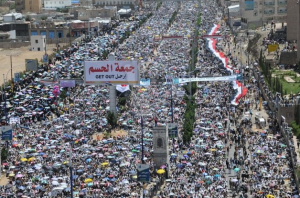By Jay R. and Gabi A.
Continued violations of the recently signed GCC power transfer agreement indicate that Yemen may be entering into a new status quo of instability.
In January of this year, Yemen’s citizenry amassed in the streets initially demanding reform and change in areas of unemployment and corruption, but then shifted their cries to the ouster of their president, Ali Abdullah Saleh. On January 27, approximately 16,000 demonstrators gathered in the capital, Sana’a, which was followed by a subsequent assembly of more than 20,000 people just one week later. But it was not until the “Friday of No Return” that the government claimed the first three lives of the revolution on March 11 setting off a wave of unrest that would escalate to opposition armed resistance in the form of an alliance between tribal chief Sheikh Sadiq al-Ahmar and General Ali Mohsen al Ahmar of the First Armored Brigade; no relation.

Some argue that the hostilities which erupted between Saleh loyalists and opposition tribesmen and defectors reached the level of civil war. The Gulf Cooperation Council (GCC) peace initiative was originally expected to quel this unrest, has appeared to have ultimately failed to do just that in the immediate term. As part of the aforementioned initiative, Yemen’s President Saleh received immunity against prosecution for his perceived crimes against the protest opposition movement. Such a concession has enraged the people, who continue their movement to express their disapproval. As such, thousands of Yemenis continued to march in the cities of Sanaa and Taiz.
Nonetheless, events have appeared to take an unexpected turn. After the formation of a joint opposition-old regime government, the prospect of returning a sense of normalcy to Yemen’s cities was palpable. Although an emboldened populace determined to see their demands realized commenced a four-day, 320 kilometer march from Taiz to Sanaa to show that actions taken thus far would not be sufficient. Moreover, what was to transpire upon the movement’s entry into the capital may shift the direction of progress forever off its course.
Demonstrators began to march under the thought protection of government forces, but once demonstrators broached the capital, their “protectors” reportedly became their assailants. The returning presence of opposition activists in the capital is apparenty a non-starter for the transitional government and as a response the government forces utilized the tactics with which the populace has become all too familiar: teargas, water cannons, and live fire, claiming an additional 13 lives.
There are two notable events, which occured around this recent escalation. One, the aforementioned General al-Ahamar of the First Armored Brigade, who was once the primary protector of the opposition activists, ensuring their safety, has thrown his support behind the recently formed transitional government. And two, the recent statements by the United States Ambassador, Gerald Feierstein, who criticized the recent opposition actions in the capital as incendiary.
It remains to be seen what the response of General al-Ahmar will be to the violence befalling the opposition demonstrators. If history is any indicator, he very well may consolidate his forces once again to take on those with continued Saleh loyalties. While the statement of the American Ambassador is surrounded in controversy in and of itself, Saleh still manages to cling to power despite his signage on the initiative and his insistence that he intends to relinquish such power. In addition, sources close to the President claim that he will soon be departing Yemen for the United States, after which, he will return to Yemen as an “opposition” figure; such matters the United States officially has no comment on. Many of Saleh’s family members and supporters remain in control of the various levers of power including the military and will prove to be an obstacle in the reconciliation process. Despite his absence, Saleh still holds the reigns of power over much of the political, military and economic system of the country.
Meanwhile, loyal units of the Yemeni military, commanded by Saleh’s son, missed a crucial deadline to withdraw from the streets of the capital, prompting rival militias to stay put as well. The removal of troops and other loyalist factions from Sana’a and other cities has become a second central condition by the opposition. It is highly unlikely that this demand will be met in the near future as there is little real incentive for the loyalists to follow through on a deal and to cede ground to the opposition. The significant lack of trust between all parties will continue to serve as a major impediment to progress in the weeks ahead.
The events of the past week cast a dark shadow on any hope instilled by the signing of the GCC initiative and as such, there should be no expectation that Yemen will see any form of stability in the near or long term. With Saleh’s continued involvement, whether it be overt or covert, the atmosphere in Yemen will remain tenuous as the opposition continues to assert their demands against him, while a once defected army leader’s actions may prove to be capricious. All of which is transpiring with a significant movement of militantcy, in the form of al-Qaeda in the Arabian Peninsula, who are awaiting the optimal time to seize on the potential security gap. The rise of such a movement, one that only Saleh has shown to be able to combat with relative effectiveness, will bring about new questions with regard to the timing of his demise and what it means for the country in the long-term. As such, despite the attempts of the transitional government to assert itself as a beacon for the future path of the country, there are clearly too many extenuating elements which are hampering its success. Perhaps its time for those accustomed to the nation-state model in the middle east to realize that stability in Yemen requires far more creative solutions.
What’s next for Yemen? Ask our analysts and get the inside scoop!